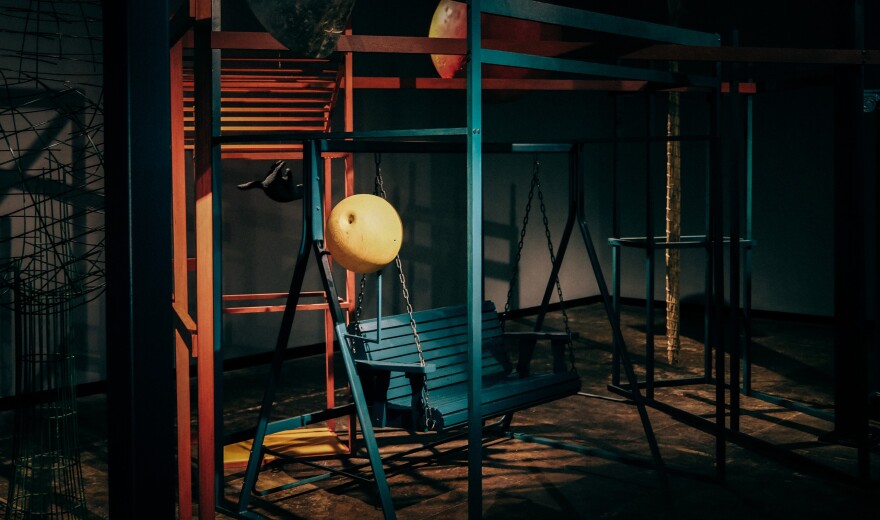Like all technologies, the book has been continually redefined. Writings that once would have been inked on papyrus or parchment for exclusive audiences are today disseminated onscreen and in audio files, as well as on paper, across far-flung distribution networks. Now an exhibition of contemporary artworks expands the typical understandings of this age-old means of storing and sharing knowledge and ideas.
BOOK, on view now through May 3 at the Beeler Gallery of Columbus College of Art and Design, features artworks by six artists with Ohio ties who convey a range of perspectives about what a book can be understood to be—a physical object to reconfigure, a connection between today and previous eras, a purveyor of sometimes challenging ideas.
“I was interested in how these different artists were thinking about a relationship with a book, which varies throughout the exhibition. Their tangency to the object is sometimes literally the book, and oftentimes it’s just analogies towards a book, or a book as a departure point,” said exhibition curator Tim Rietenbach, faculty director of exhibitions for Columbus College of Art and Design.
In some of the exhibition’s works, artists take inspiration from the book as an object of and in history, bearing the physical marks of its real or imagined journey through time. A series of collage-based works by Brooklyn-based CCAD alumnus Kent Rhodebeck’s Ongoing Selection is derived from Rhodebeck’s interest in bookbinding and in creating his own sketchbooks. The book-sized wall objects feature carving, oil pastel work, fabric and other media joined together in expressions of the artist’s self.
“I’m looking for the same spirit as doodling, drawing, pasting things in a sketchbook,” Rhodebeck said. “The sketchbook is more of a personal thing. When it's in the book, it's closed, I guess, kind of intimate. These (works) kind of have the same spirit.”

The Snow Leopard, by Justin Sorensen, assistant professor of art at Mount Vernon Nazarene University, takes its title and inspiration from Peter Matthiessen’s book The Snow Leopard, a detailed account of the author’s taxing two-month quest to find a snow leopard in Tibet.
Sorensen’s work reassembles squares cut from the pages of 30 calendars into a large-scale mosaic-like installation. The work references the temporal dimension of the quest for the snow leopard in Matthiessen’s book, distilling it into an artwork that, mounted on a single large wall, has an expansive, epic feel.
“It’s really more of a correlation of time than it is about a direct correlation of the storyline of the book,” Rietenbach said.
Other works in BOOK explore the specific content of books. In The Day Before Tomorrow: Sites and Footprints of ICE Detention Centers, Yellow Springs-based artist Migiwa Orimo graphically maps the footprints of ICE detention centers in traditional Japanese sumi ink onto pages taken from Eric Partridge’s A Dictionary of the Underworld, an American- and British-English lexicon of the criminal world. Born of the idea of the book as a repository of knowledge and a medium of artistic expression, The Day Before Tomorrow reflects Orimo’s archival research and social justice stance.
Mark Harris, professor at the University of Cincinnati School of Art, joins posters and graffiti protesting wars during two different historical periods in a series of two-dimensional wall-mounted works. Overlaying reproductions of posters protesting the 1848 Paris rebellion with images of graffiti made in the 1968 Paris uprising, Harris’ work reflects a continuity of unrest across eras, as captured in two forms of documentation.

“He’s kind of sandwiching two time periods by overlapping in each image. And they’re found from different publications, so the books in this case are resources for the research, and the images are appropriated from the books,” Rietenbach said.
Harris’ video installation Predatory Botany discusses the history and contents of 18th-century illustrated books on plants in the Caribbean Islands. The 30-minute film brings to the fore the racial justice implications of the work of enslaved people not acknowledged in the book for their help to the authors’ research in the Caribbean.
Race is at the center of Stars Falling, a collaborative sculpture and video installation work by sculptor Todd Slaughter, professor of art at the Ohio State University, and Ohio State alumna Melissa Yes, assistant professor of art at the University of Alabama. The artists take Harper Lee’s To Kill a Mockingbird and her earlier (though more recently published) novel Go Set a Watchman as a starting point for conversations about race dynamics in the U.S.
In particular, problematic aspects of the character of Atticus Finch are brought to the fore in a series of videorecorded interviews with individuals in the artists’ immediate spheres, including multiple Pulitzer Prize-winning journalist John Archibald and Dr. Terron Banner, manager of community learning and experience at OSU’s Urban Art Space. Viewers can watch Yes’ edited video interviews amid installed sculptural elements, which Slaughter designed to welcome viewers into the conversation.

“The Sculpture aspect I see is intended to have people feel conversational. So there’s a lot of seating integrated into the sculpture. You’re encouraged to sit down, to spend time. We want to slow people down. We want them to experience this and to want to go through as much of these conversations as possible,” said Slaughter.
Together, the works on display in BOOK expand the typical view of a book as a thing with pages packed with words, but they do much more than that. Like all good books, the works in this exhibition has the power to help us look more deeply and, maybe, to see ourselves more clearly.
BOOK, is on view now through May 3 at the Beeler Gallery of Columbus College of Art and Design.


